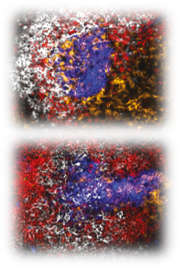Regulation of adaptive immunity during chronic viral infections

Immune control of viral infections is in most cases dependent on adaptive immunity. While acute/resolved infections are completely cleared from the host, persistent viral infections are, by definition, not eliminated by the host's immune system and are often associated with relevant clinical disease outcomes. Persistent viral infections may be classified into a) highly productive and replicative infections (associated with continuous high level of virus replication) and b) latent/reactivating infections (associated with low level viral reactivation events in immune-competent hosts). Viruses falling into these two categories have evolved diverse strategies for co-existence within an immune-competent host. While functional and physical downregulation of virus-specific adaptive immunity and mutational escape from immune pressure are common features of the former, viruses which cause latent/reactivating infections have evolved strategies to interfere with host immunity (immune evasion mechanisms) and have acquired genetic programs which facilitate a latent, non-replicative existence of the viral genetic information with the option of resuming lytic viral replication which is normally rapidly controlled in immune-competent individuals.
One important challenge in the context of actively replicating persistent infections is how immunity ought to be regulated such that it affords optimal control of the infection without causing harmful immunopathology. Addressing this question is one major aim of our research activities.
Murine lymphocytic choriomeningitis virus (LCMV) infection is a well-established model of acute or chronic viral infection of the highly productive and replicative type. In the context of persistent chronic LCMV infection we focus on the role of immune-regulatory pathways which contribute to functional and physical T cell downregulation and its consequences for viral control and health of the host. We use state-of-the-art single cell transcriptomic analyses coupled to advance bioinformatic analyses to delineate the differentiation trajectories of virus-specific CD8 T cells and B cells during acute and chronic viral infection. We also investigate the fate and function of CD4 T helper cells during persistent LCMV infection with particular emphasis on their role in supporting long-term evolution of virus-specific antibody responses.
Related publications:
Richter, K., P. Agnellini, and A. Oxenius. 2010. On the role of the inhibitory receptor LAG-3 in acute and chronic LCMV infection. Int Immunol 22: 13-23. [external page Abstract]
Wiesel, M., N. Joller, A. K. Ehlert, J. Crouse, R. Sporri, M. F. Bachmann, and A. Oxenius. 2010. Th cells act via two synergistic pathways to promote antiviral CD8+ T cell responses. J Immunol 185: 5188-5197. [external page Abstract]
Graw, F., K. Richter, A. Oxenius, and R. R. Regoes. 2011. Comparison of cytotoxic T lymphocyte efficacy in acute and persistent lymphocytic choriomeningitis virus infection. Proc Biol Sci 278: 3395-3402. [external page Abstract]
Wiesel, M., W. Kratky, and A. Oxenius. 2011. Type I IFN substitutes for T cell help during viral infections. J Immunol 186: 754-763. [external page Abstract]
Frebel, H., V. Nindl, R. A. Schuepbach, T. Braunschweiler, K. Richter, J. Vogel, C. A. Wagner, D. Loffing-Cueni, M. Kurrer, B. Ludewig, and A. Oxenius. 2012. Programmed death 1 protects from fatal circulatory failure during systemic virus infection of mice. J Exp Med 209: 2485-2499. [external page Abstract]
Richter, K., T. Brocker, and A. Oxenius. 2012. Antigen amount dictates CD8+ T-cell exhaustion during chronic viral infection irrespective of the type of antigen presenting cell. Eur J Immunol 42: 2290-2304. [external page Abstract]
Wiesel, M., J. Crouse, G. Bedenikovic, A. Sutherland, N. Joller, and A. Oxenius. 2012. Type-I IFN drives the differentiation of short-lived effector CD8+ T cells in vivo. Eur J Immunol 42: 320-329. [external page Abstract]
Richter, K., and A. Oxenius. 2013. Non-neutralizing antibodies protect from chronic LCMV infection independently of activating FcgammaR or complement. Eur J Immunol 43: 2349-2360. [external page Abstract]
Richter, K., G. Perriard, R. Behrendt, R. A. Schwendener, V. Sexl, R. Dunn, M. Kamanaka, R. A. Flavell, A. Roers, and A. Oxenius. 2013. Macrophage and T cell produced IL-10 promotes viral chronicity. PLoS Pathog 9: e1003735. [external page Abstract]
Richter, K., G. Perriard, and A. Oxenius. 2013. Reversal of chronic to resolved infection by IL-10 blockade is LCMV strain dependent. Eur J Immunol 43: 649-654. [external page Abstract]
Schmitz, I., C. Schneider, A. Frohlich, H. Frebel, D. Christ, W. J. Leonard, T. Sparwasser, A. Oxenius, S. Freigang, and M. Kopf. 2013. IL-21 Restricts Virus-driven Treg Cell Expansion in Chronic LCMV Infection. PLoS Pathog 9: e1003362. [external page Abstract]
Bedenikovic, G., J. Crouse, and A. Oxenius. 2014. T-cell help dependence of memory CD8(+) T-cell expansion upon vaccinia virus challenge relies on CD40 signaling. Eur J Immunol 44: 115-126. [external page Abstract]
Crouse, J., G. Bedenikovic, M. Wiesel, M. Ibberson, I. Xenarios, D. Von Laer, U. Kalinke, E. Vivier, S. Jonjic, and A. Oxenius. 2014. Type I Interferons Protect T Cells against NK Cell Attack Mediated by the Activating Receptor NCR1. Immunity 40: 961-973. [external page Abstract]
Garcia, V., K. Richter, F. Graw, A. Oxenius, and R. R. Regoes. 2015. Estimating the In Vivo Killing Efficacy of Cytotoxic T Lymphocytes across Different Peptide-MHC Complex Densities. PLoS Comput Biol 11: e1004178. [external page Abstract]
Greczmiel, U., N. J. Krautler, A. Pedrioli, I. Bartsch, P. Agnellini, G. Bedenikovic, J. Harker, K. Richter, and A. Oxenius. 2017. Sustained T follicular helper cell response is essential for control of chronic viral infection. Sci Immunol 1;2(18) [external page Abstract]
Yermanos, A., V. Greiff, N. J. Krautler, U. Menzel, A. Dounas, E. Miho, A. Oxenius, T. Stadler, and S. T. Reddy. 2017. Comparison of methods for phylogenetic B-cell lineage inference using time-resolved antibody repertoire simulations (AbSim). Bioinformatics. [external page Abstract]
Greczmiel, U., and A. Oxenius. 2018. The Janus Face of Follicular T Helper Cells in Chronic Viral Infections. Front Immunol 9: 1162. [external page Abstract]